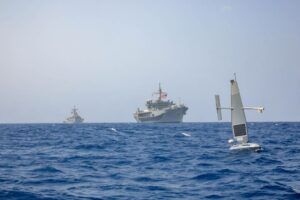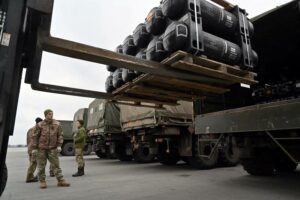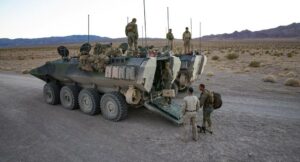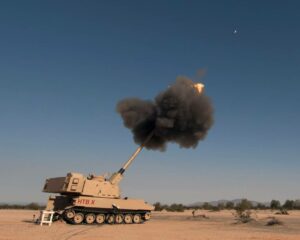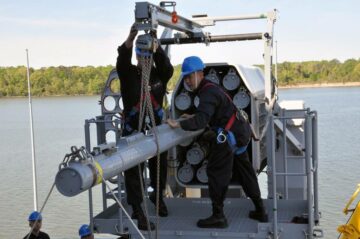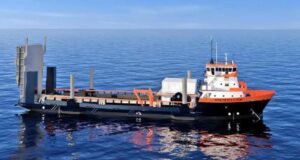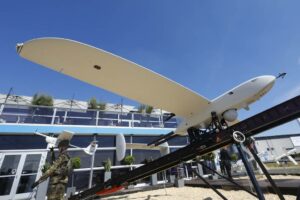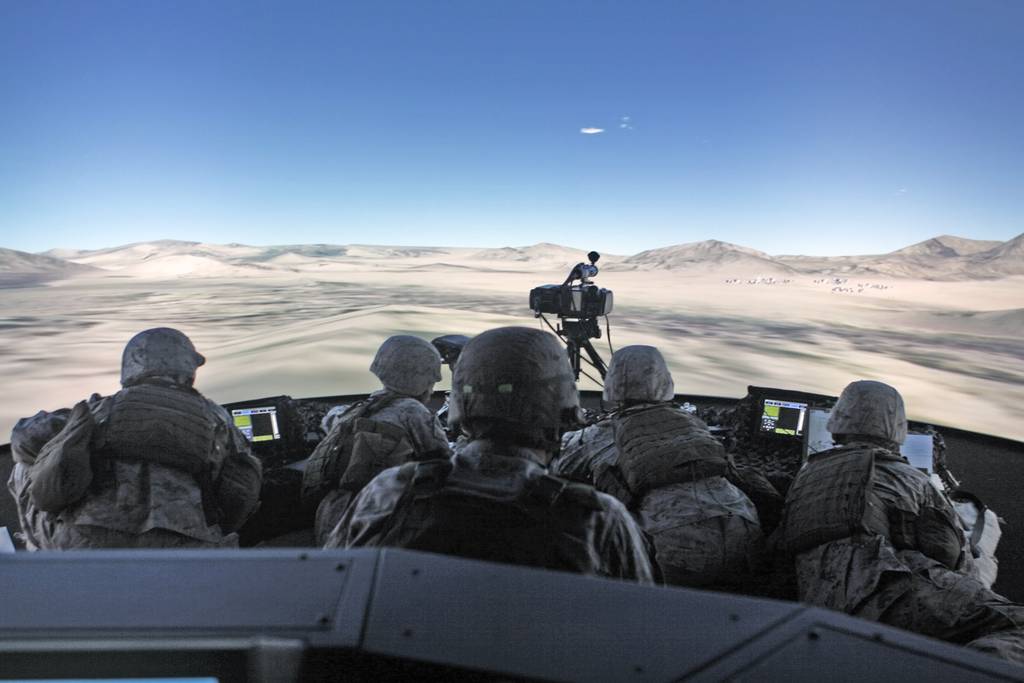
WASHINGTON — U.S. Marines training at home and abroad will see changes in 2024, as an ongoing effort to replace legacy simulators with state-of-the-art systems picks up speed.
Project Tripoli, which started in 2022 as part of the Force Design modernization initiative, aims to create a live-virtual-constructive training environment that Marines can leverage at large training bases and in remote locations.
Already the Marine Corps has married its training network with the Navy’s more robust version, shifting from large training facilities to laptops and adopting a joint set of training simulations. Marines on the ground will notice more changes in early 2024, Project Tripoli leaders told Defense News.
Improving live training
On the live side, the Corps is set to debut its Marine Corps Tactical Instrumentation System, or MCTIS, which has nearly completed government acceptance trials at Marine Corps Air Ground Combat Center Twentynine Palms, California.
Jim Brown, deputy director of the Range and Training Programs Division at the service’s Training and Education Command, said MCTIS will track every Marine, vehicle and weapon during a training event in the field, as well as their location, heath status and more. That data will be fed to a central location, creating a digital twin of what’s happening in the exercise.
Its ability to record every move and every shot — both live and simulated, and against real and simulated targets — will benefit both the Marines on the ground and the commanders back at headquarters, he said.
Brown said having a full view of the live, virtual and constructive actions during the event will allow commanders to see much more during their after-action reviews, leading to better lessons learned.
Col. Dane Salm, the director of the Range and Training Programs Division, said in the same interview that MCTIS would also “drastically change” the experience of Marines in the field. As they go through patrols, instructors in the field have always been able to pause the action if something is unsafe, to try to adjudicate who shot whom, and more. But now, Salm said, the instructors will be able to show a squad leader on a tablet what they had planned to do versus what they actually executed — giving real-time, visual cues as to what went wrong, while also allowing the squad to start over.
MCTIS will make its formal debut in February at the Marine Air-Ground Task Force (MAGTF) Warfighting Exercise 2-24 at Twentynine Palms, Salm said.
More flexible virtual trainers
On the virtual side of the training portfolio, Salm said the Corps is in the midst of an extended user evaluation involving two options to replace the Supporting Arms Virtual Trainer, previously located at the Dome — a large building that was expensive to maintain and only existed at a few locations.
Instead, Marines will move to a Joint Virtual Fires Trainer, where Marines outfitted with goggles and hand-held wands will conduct virtual training scenarios run through an application on a gaming laptop.
The Marine Corps is putting two companies through the evaluation at Twentynine Palms; Marine Corps Air Station Yuma, Arizona; and Marine Corps bases Camp Lejeune in North Carolina and Camp Pendleton in California.
Salm said this effort will unshackle Marines from having to go to a certain building for training — meaning more Marines could train at once, train from remote posts or their barracks, and run more scenarios.
The new Joint Virtual Fires Trainer will “multiply the amount of individuals that we’re training and certifying as [joint terminal attack controllers] for the fleet,” Salm said.
Similarly, Joseph Lomangino, action officer for Project Tripoli, said in an interview the service had already discontinued use of its Combined Arms Command and Control Training Upgrade System, or CACCTUS, which similarly involved a lot of computers and server stacks in a large building.
“We determined we can achieve the same training and increase the density of that training across the Marine Corps by replacing the CACCTUS with the [Marine Common Virtual Platform],” he said, referring to a common laptop with open standards that could be used for a range of live, virtual and constructive training needs.
About 1,600 laptops for combined arms and close-air support training have replaced six CACCTUS locations across the Corps. The Marine Common Virtual Platform will replace those laptops once the service chooses the final hardware, Lomangino said.
That same laptop will also be used in the final Joint Virtual Fires Trainer, he added.
‘Something better’
This move to laptop-based training only works if they are connected to a robust network with realistic simulations and scenarios, Lomangino noted.
The Corps developed the Marine Training Enterprise Network and has since connected it to the Navy’s larger Navy Continuous Training Environment, itself available globally and around the clock.
Now, “instead of units having to pile into a center or fly to a center,” they can use laptops to conduct training anywhere — and alongside anyone else in the virtual environment,“ Lomangino said. “You can have units in different, disparate locations train together in that environment.”
Brown said the simulations will also be better, as Marines are ditching the MAGTF Tactical Warfare Simulation that’s nearly four decades old and moving instead of the Joint Live Virtual Constructive Federation.
“[The MAGTF Tactical Warfare Simulation] was a great simulation. … It did everything, but it did it about an inch deep,” Brown said. “As we move into new training environments that are being dictated by new operational environments, we need something better.”
The Joint LVC Federation includes high-quality simulations that all the services and combatant commands will use. Salm said the exercise Steel Knight — a naval, joint and international training exercise that recently concluded at Camp Pendleton — leveraged the Navy Continuous Training Environment network and the Joint LVC Federation.
“Every exercise we see, either going on at Twentynine Palms or even in the Pacific, like Balikatan next year, we’re going to continue to build upon the last exercise and adding more and more and more aspects of [Project] Tripoli to it,” Salm added.
The current fiscal year was meant to pave the way for the larger proliferation of laptops and other hardware that would be fielded in fiscal 2025 and fiscal 2026, Lomangino said. But the ongoing continuing resolution funding the government has hindered the effort, as the measure doesn’t allow the Corps to start new programs nor increase spending on existing programs.
The three officials declined to talk about planned or actual spending for Project Tripoli, due to ongoing budget uncertainty.
However, Lomangino said that by divesting of single-task trainers and replacing them with commercial and government off-the-shelf technology that already exists, the Corps is able to go from “a limited LVC capability to an enterprise-level LVC capability without having to go through massive, extreme expenditures.”
Brown said the effort would certainly lead to cost savings in the future because the service won’t have to maintain massive buildings that house large trainers, and it will be cheaper to upgrade laptops rather than replace entire trainers that become obsolete.
But, he added, those savings are a secondary or tertiary benefit.
“The application of virtual [and] constructive alongside the live is meant to produce a better trained Marine and a more combat-ready organization. You can equate it to a pitcher in the bullpen warming up before stepping onto the mound,” Brown said.
“The reason we’re doing this is Force Design, and Force Design needs this to be successful. And I don’t want to overhype it, but the concepts and the formations and the capabilities — if they don’t have a trained Marine with their hands on those and executing those, Force Design would fail.”
Megan Eckstein is the naval warfare reporter at Defense News. She has covered military news since 2009, with a focus on U.S. Navy and Marine Corps operations, acquisition programs and budgets. She has reported from four geographic fleets and is happiest when she’s filing stories from a ship. Megan is a University of Maryland alumna.
- SEO Powered Content & PR Distribution. Get Amplified Today.
- PlatoData.Network Vertical Generative Ai. Empower Yourself. Access Here.
- PlatoAiStream. Web3 Intelligence. Knowledge Amplified. Access Here.
- PlatoESG. Carbon, CleanTech, Energy, Environment, Solar, Waste Management. Access Here.
- PlatoHealth. Biotech and Clinical Trials Intelligence. Access Here.
- Source: https://www.defensenews.com/training-sim/2023/12/29/marines-to-roll-out-improvements-to-live-simulated-training-in-2024/
- :has
- :is
- :where
- $UP
- 1
- 11
- 2013
- 2015
- 2020
- 2022
- 2024
- 2025
- 2026
- 600
- 70
- 9
- a
- ability
- Able
- About
- abroad
- acceptance
- Achieve
- acquisition
- across
- Action
- actions
- actual
- actually
- added
- adding
- Adopting
- against
- aims
- AIR
- All
- allow
- Allowing
- alongside
- already
- also
- always
- amount
- an
- and
- anyone
- anywhere
- Application
- ARE
- arizona
- arms
- around
- AS
- aspects
- At
- attack
- available
- back
- BE
- because
- become
- been
- before
- being
- benefit
- Better
- both
- brown
- budget
- Budgets
- build
- Building
- but
- by
- calculates
- calif
- california
- Camp
- CAN
- capabilities
- capability
- Carolina
- Center
- central
- certain
- certainly
- Changes
- cheaper
- Clock
- combat
- combined
- commercial
- Common
- Companies
- Completed
- computers
- concepts
- concluded
- Conduct
- connected
- constructive
- continue
- continuing
- continuous
- control
- Cost
- cost savings
- could
- covered
- create
- Creating
- Current
- data
- debut
- decades
- deep
- Defense
- density
- deputy
- DESERT
- Design
- determined
- developed
- device
- dictated
- DID
- different
- digital
- digital twin
- Director
- disparate
- distance
- Division
- do
- Doesn’t
- doing
- Dont
- due
- during
- Early
- Education
- effort
- either
- else
- emergency
- Enterprise
- enterprise-level
- Entire
- Environment
- environments
- evaluation
- Even
- Event
- Every
- everything
- executed
- executing
- Exercise
- existing
- exists
- expensive
- experience
- extended
- extreme
- facilities
- Facility
- FAIL
- February
- Fed
- Federation
- feedback
- few
- field
- Filing
- final
- fires
- Fiscal
- FLEET
- flexible
- Focus
- For
- Force
- formal
- four
- from
- full
- funding
- future
- gaming
- geographic
- Giving
- Globally
- Go
- going
- Government
- great
- Ground
- had
- Hands
- Happening
- Hardware
- Have
- having
- he
- Headquarters
- high-quality
- hindered
- Home
- House
- HTTPS
- i
- if
- images
- improvements
- in
- includes
- Increase
- individuals
- Initiative
- instead
- International
- Interview
- into
- involved
- involving
- IT
- ITS
- itself
- joint
- jpg
- Knight
- laptop
- laptops
- large
- larger
- Last
- lead
- leader
- leaders
- leading
- learned
- left
- Legacy
- Lessons
- Lessons Learned
- Leverage
- leveraged
- like
- Limited
- live
- located
- location
- locations
- Lot
- maintain
- make
- Marine
- Maryland
- massive
- meaning
- meant
- measure
- Megan
- Military
- modernization
- more
- move
- moving
- much
- nearly
- Need
- needs
- network
- New
- news
- next
- nor
- North
- north carolina
- noted
- Notice..
- now
- obsolete
- of
- Officer
- officials
- Old
- on
- once
- ongoing
- only
- open
- operational
- Operations
- Options
- or
- organization
- Other
- out
- over
- Pacific
- part
- pause
- pave
- Picks
- planned
- platform
- plato
- Plato Data Intelligence
- PlatoData
- portfolio
- Posts
- previously
- produce
- Programs
- project
- provides
- Putting
- raid
- range
- rather
- real
- real-time
- realistic
- reason
- recently
- record
- remote
- replace
- replaced
- Reported
- reporter
- Resolution
- Reviews
- robust
- Roll
- Run
- s
- Said
- same
- Savings
- scenarios
- secondary
- see
- server
- service
- Services
- set
- shawn
- she
- SHIFTING
- ship
- shot
- show
- side
- Similarly
- simulation
- since
- SIX
- something
- southeast
- speed
- Spending
- Stacks
- standards
- start
- started
- state-of-the-art
- station
- Status
- steel
- stepping
- Stories
- successful
- support
- Supporting
- system
- Systems
- Tablet
- tactical
- Talk
- Target
- targets
- Task
- task force
- Technology
- Terminal
- tertiary
- than
- that
- The
- The Future
- the joint
- their
- Them
- they
- this
- those
- three
- Through
- to
- together
- told
- track
- Train
- trained
- Training
- trials
- try
- twin
- two
- u.s.
- U.S. Navy
- Uncertainty
- units
- university
- University of Maryland
- upgrade
- upon
- use
- used
- User
- vehicle
- version
- Versus
- View
- Virtual
- visual
- want
- was
- Way..
- we
- WELL
- went
- What
- when
- which
- while
- WHO
- whom
- will
- william
- with
- without
- works
- would
- Wrong
- year
- you
- zephyrnet

